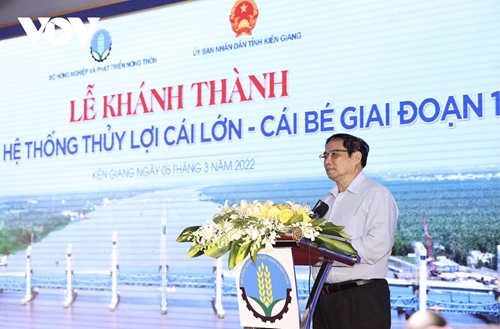Regarded as the biggest of its kind in Vietnam, the irrigation system is intended to control salinity in the five provinces of Ca Mau, Bac Lieu, Soc Trang, Hau Giang and Kien Giang, helping to save billions of VND for the State budget. It will also serve as an agricultural highlight in the western region.
The construction of the first phase began in November 2019 with total investment capital of over VND 3.3 trillion (USD 144.48 million).
    |
 |
|
Prime Minister Pham Minh Chinh addresses the event. Photo: vov |
Once fully operational, the system is expected to facilitate stable and sustainable production on an area of 384,120 hectares, including nearly 347 hectares of agriculture and fishery.
This is one of the major projects rolled out in line with the Government’s Resolution No. 120, PM Chinh stressed, adding that the system and western sea dykes will help to control natural disasters, rising sea level and flooding.
It will also give a facelift to rural areas, accelerate sustainable agricultural restructuring in the Mekong Delta in general and localities included in the project in particular, contributing to reducing poverty and raising local people's living standards.
The PM asked local authorities and people to join hands with the Ministry of Agriculture and Rural Development in the use of the system, which, he said, would be utilized in tourism.
PM Chinh also expressed his belief that with projects like the Cai Lon - Cai Be irrigation system, the Mekong Delta will enter a new development period with breakthroughs, and develops rapidly and sustainably.
Source: VNA